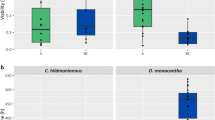Abstract
Aedeagal morphology of two sibling cactophilic species, Drosophila buzzatii Patterson & Wheeler and Drosophila koepferae Fontdevila & Wasserman, was analyzed in nine allopatric and three sympatric locations throughout South America. Morphological differences were detected for both aedeagus size and shape between sympatric and allopatric populations of D. buzzatii, despite the significant variability within both groups. Populations of D. buzzatii sympatric with D. koepferae displayed smaller aedeagus than the allopatric ones as well as more differentiated aedeagus shape. The shape differences were non-allometric and mainly consisted in a change of curvature of the dorsal margin of the aedeagus being more pronounced in males from populations sympatric with D. koepferae. It is concluded that aedeagal morphology presented some degree of character displacement in both size and shape in populations of D. buzzatii in sympatry with D. koepferae. These results might suggest the existence of mechanisms of interspecific recognition and hybridization prevention between these species that include the morphology of the male genitalia.



Similar content being viewed by others
References
Burke JM, Arnold ML (2001) Genetics and the fitness of hybrids. Annu Rev Genet 35:31–52
Carreira VP, Soto IM, Fanara JJ, Hasson E (2006) Patterns of variation in wing morphology in the cactophilic Drosophila buzzatii and its sibling D. koepferae. J Evol Biol 9(4):1275–1282
Coyne JA, Orr HA (2004) Speciation. Sinauer, Sunderland
Fanara JJ, Fontdevila A, Hasson E (1999) Oviposition preference and life history traits in the cactophilic Drosophila koepferae and D. buzzatii in association to their natural hosts. Evol Ecol 13:173–190
Gómez GA, Hasson E (2003) Transpecific polymorphisms in an inversion linked esterase locus in Drosophila buzzatii. Mol Biol Evol 20:410–423
Hood GM (2010) PopTools version 3.2.5. Available at: http://www.poptools.org
Iwata H, Ukai Y (2002) SHAPE: a computer program package for quantitative evaluation of biological shapes based on elliptic Fourier descriptors. J Hered 93:384–385
Jagadeeshan S, Singh RS (2006) A time-sequence functional analysis of mating behaviour and genital coupling in Drosophila: role of cryptic female choice and male sex-drive in the evolution of male genitalia. J Evol Biol 19:1058–1070
Kuhl FP, Giardina CR (1982) Elliptic Fourier features of a closed contour. Comp Graph Image Proc 18:236–258
Machado LPB, Madi-Ravazzi L, Castro JP (2002) Evaluation of the courtship and of the hybrid male sterility among Drosophila buzzatii cluster species (Diptera, Drosophilidae). Rev Brasil Biol 62:601–608
Manfrin MH, DeBrito ROA, Sene FM (2001) Systematics and evolution of Drosophila buzzatii cluster using mtDNA. Ann Entomol Soc Am 94:333–346
Manfrin MH, Sene FM (2006) Cactophilic Drosophila in South America: a model for evolutionary studies. Genetica 126:57–75
Marín I, Ruiz A, Pla C, Fontdevila A (1993) Reproductive relationships among ten species of the Drosophila repleta group from South America and the West Indies. Evolution 47:1616–1624
Marín I, Fontdevila A (1998) Stable Drosophila buzzatii – Drosophila koepferae hybrids. J Hered 89:336–339
Moraes EM, Sene FM (2002) Breeding structure of an isolated cactophilic Drosophila population on a sandstone table hill. J Zool Syst Evol Res 40:123–128
Naveira H, Fontdevila A (1986) The evolutionary history of Drosophila buzzatii: XII. The genetic basis of sterility in hybrids between D. buzzatii its sibling D. serido from Argentina. Genetics 114:841–857
Piccinali R, Aguadé M, Hasson E (2004) Comparative molecular population genetics of the Xdh locus in the cactophilic sibling species Drosophila buzzatii and D. koepferae. Mol Biol Evol 21:141–152
Piccinali R, Mascord LJ, Barker JSF, Oakeshott JG, Hasson E (2007) Molecular population genetics of the ∝-esterase 5 gene locus in original and colonized populations of Drosophila buzzatii and its sibling Drosophila koepferae. J Mol Evol 64:158–170
Rodríguez C, Piccinali R, Levy E, Hasson E (2000) Contrasting population genetic structures using allozymes and the inversion polymorphism in Drosophila buzzatii. J Evol Biol 13:976–984
Rohlf FJ (2001). TPSDig. Dep. Ecol. Evol. New York University, Stony Brook, NY
Sánchez A (1986) Phylogenetic relationships in Drosophila martensis and D. buzzatii clusters. PhD dissertation. Universitat Autònoma de Barcelona, Barcelona, in Spanish
Santos M, Ruiz A, Barbadilla A, Quezada-Díaz JE, Hasson E, Fontdevila A (1988) The evolutionary history of Drosophila buzzatii: XlV. Larger flies mate more often in nature. Heredity 61:255–262
Silva AFG, Sene FM (1991) Morphological geographic variability in Drosophila serido (Diptera, Drosophilidae). Rev Bras Entomol 35:455–468
Soto IM (2005) Use of elliptic Fourier descriptors for quantification of male genitalia morphology. Dros Inf Serv 88:42–45
Soto IM, Carreira VP, Fanara JJ, Hasson E (2007) Evolution of male genitalia: environmental and genetic factors affecting genital morphology in two Drosophila sibling species and their hybrids. BMC Evol Biol 7:77
Soto EM, Soto IM, Carreira VP, Fanara JJ, Hasson E (2008) Host-related life history traits in interspecific hybrids of cactophilic Drosophila. Entomol Exp Appl 126:18–27
StatSoft Inc. (2007) STATISTICA (data analysis software system), version 8.0. www.statsoft.com
Vilela CR (1983) A revision of the Drosophila repleta species group (Diptera, Drosophilidae). Rev Bras Entomol 27:1–114
Acknowledgments
Thanks are extended to VP Carreira, E Hasson, N Lavagnino and JJ Fanara for sample collection. I also thank E Soto, VP Carreira and E Hasson for insightful comments during the elaboration of this manuscript. I am also grateful to the three anonymous reviewers for their comments and constructive criticisms that helped to improve the previous version of this paper. This work was supported by CONICET and grants of Universidad de Buenos Aires and Agencia Nacional de Promoción Científica y Técnica (ANPCyT).
Author information
Authors and Affiliations
Corresponding author
Additional information
Edited by Roberto A Zucchi – ESALQ/USP
Rights and permissions
About this article
Cite this article
Soto, I.M. Aedeagal Divergence in Sympatric Populations of Two Sibling Species of Cactophilic Drosophila (Diptera: Drosophilidae): Evidence of Character Displacement?. Neotrop Entomol 41, 207–213 (2012). https://doi.org/10.1007/s13744-012-0028-x
Received:
Accepted:
Published:
Issue Date:
DOI: https://doi.org/10.1007/s13744-012-0028-x




